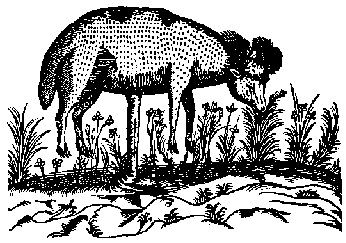Barometz
also known as Vegetable-Lambs of Linnea
The air is replete with the bleats of sheep. As you move closer to the cliff edge, you see a vast multitude of sheep, some of them still attached to their nursery plants via their umbilical cords. These are the famous barometz or vegetable-lambs of Linnea. At this moment, you feel a sense of belonging embrace you.
Welcome to Linnea, Kingdom of the Gravid Queens. — The Wanderer's Journal, The Kingdoms of the Empire of Ziruna Uletl, vol. 5
Basic Information
The bodies of vegetable lambs are covered by a coat of thick cotton-like plant fiber to protect them from cold. This coat contains long, stiff hairs, called kemps, over a short, woolly undercoat, which grows in autumn and is shed in spring. This woolly undercoat has been developed in many breeds into a fleece of long wool, with selection against kemp hairs in these breeds.
If left unpruned, both rams and ewes have horns, while in tended lambs (depending upon breed) horns may be present in both rams and ewes, in rams only, or in neither. Rams' horns may be very large – reaching weights of up to 14 kg (31 lb) – as much as the bones of the rest of its body put together. Rams use their horns to fight with each other for dominance and the right to mate with females. In most cases, they do not injure each other because they hit each other head to head and their curved horns do not strike each other's bodies. They are also protected by having very thick skin and double-layered skulls.
Wild sheep have very keen senses of sight and hearing. When detecting predators, wild sheep most often flee, usually uphill to higher ground. However, they can also fight back. The Dall sheep has been known to butt wolves off the face of cliffs.
Sheep have scent glands on their faces and feet. Communication through the scent glands is not well understood, but is thought to be important for sexual signaling. Males can smell females that are fertile and ready to mate, and rams mark their territories by rubbing scent on rocks.
Vegetable-lambs are hermaphroditic with both rams and ewes possessing both stamen and pistil. After fertilization, both ram and ewe grow small seedpods underneath their wool which fall off wherever a vegetable-lamb treads. Mating cycles occur annually with vegetable-lambs reaching maturity when their umbilical cords detach.
2-3 days after falling off either a ram or an ewe, the seed pods burrow underground and slowly begin sprouting. Over the course of a week, a small broad-leafed plant measuring 2.5 - 3 ft. across grows at the site. After a month, a small bud will sprout from the top of the plant to reveal a tiny infant vegetable-lamb (1.5 - 2 in. long).
In 4-5 months, the lamb has grown enough to supplement the nutrients from its nursery plant with additional grazing.
Vegetable lambs conserve water well and can live in fairly dry environments.
Their diets consist mainly of nutrients from their root systems, grasses, as well as other plants and lichens.
Additional Information
The fleece covers the body (in a few breeds also the face and legs) and is used for fiber. Depending on the breed, the fleece ranges in color from white, black, brown, russet, or even spotted. Tended vegetable-lambs are also kept for their flesh with almost all of their parts (except their bones) being edible.
The age of a barometz changes the tenderness and the flavor of the flesh. The youngest lambs still with their umbilical chords have the sweetest and most tender of meat and vegetable parts while the oldest of rams have a thick, hearty texture with nuttier and gamier flesh.
Vegetable-lambs are kept almost exclusively within the lands of the Kingdom of Linnea. Seedpods as well as mature rams and ewes are heavily guarded trade secrets by the kingdom.
Average Weight
Vegetable lambs are fairly small compared to other chimeric breeds; in most breeds, adults weigh less than 100 kg (220 lb). Males are usually heavier than females by a significant amount.
Flavor Profile:
Overall, the vegetable-lamb has a crisp, nutty flavor with hints of honey and gamey meat. Depending on which parts of the barometz are consumed, various flavors may be experienced. The eyes are sweet as plump grapes while the leg is as fat and as juicy as the choicest hog. The internal fluids are as rich as honey while the ears are flavorless and crunchy but take to sauces easily like certain edible fungi.
Notable works mentioning the Barometz:
- Medical Wonders of the Linneans
Entry for Summer Camp 2019
Answering: "
Write about an important plant in your world and what it is used for."











Ooh i like this article! You definitely managed to portray one of the weirdest species i have seen in an amazing way i would say! I really love the very concept of this article! I overall, have not much to say about this article to be frank as to why i liked it. The only thing i specifically liked was the concept of the vegetable lamb itself, which was something weird that you managed to pull off spectacularly! I think that in itself was my favourite part of the article! As for the content questions, i have a few that arose in my mind! 1) How are Barometzes domesticated? 2) How do they live in their natural habitats? Any predators or prey they depend upon? 3) When were the Barometzes first discovered? How did they come to be tamed? I sadly cant say anymore about this article due to how sleepy i am at the moment XD. I still did like it though and did my best to critique it! Congrats avalon and keep up the amazing work!
Heya BC! Barometzes are based on an old medieval creature of the same name. As for your questions, here are some answers: 1) They were grown and cultivated not domesticated. The country who breeds these are experts in husbandry and agricultural magic. 2) They are raised just like normal sheep do with all the attendant predators who prey upon them if they aren't properly looked after. 3) See answer #1.